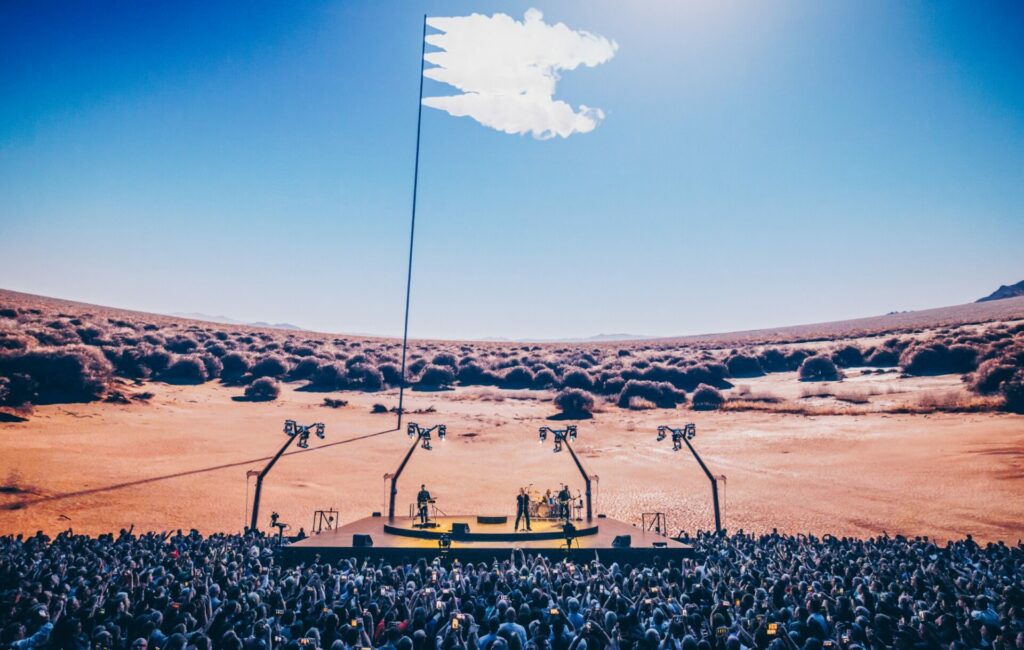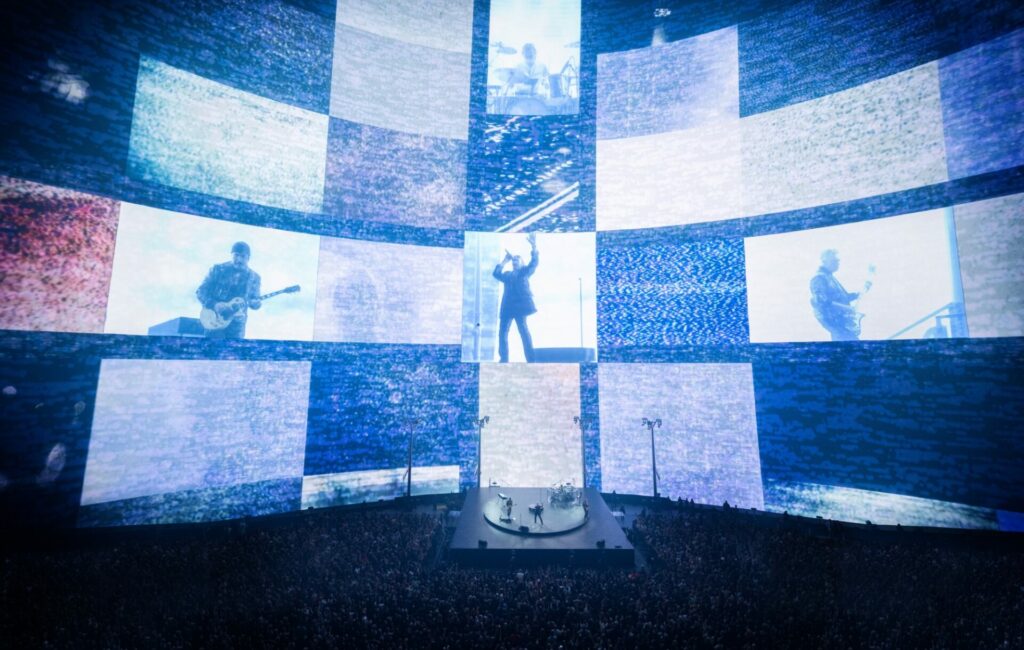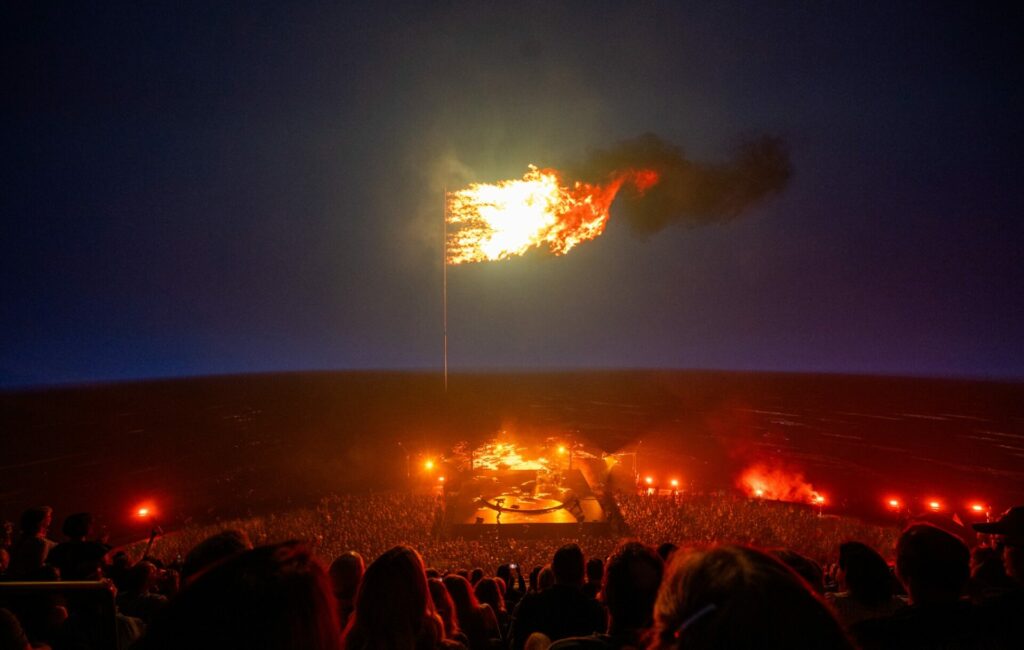U2 creative director Willie Williams talks stunning Sphere residency
The band are opening the boundary-pushing new Las Vegas venue with an ‘Achtung Baby’-themed residency that runs until Christmas.

Willie Williams, U2’s longtime creative director and set designer, has spoken to Rolling Stone UK about the band’s boundary-pushing residency at Las Vegas’ new Sphere venue, which opened last month.
U2: UV Achtung Baby celebrates the band’s iconic 1991 album, and sees them open the huge and visually stunning new venue, which features a 500ft-wide screen, the highest-resolution LED screen on the planet.
Williams, a part of Treatment Studio, was first approached by Bono with the idea of the residency early in 2022, and spent the next 18 months sculpting the show alongside the building of the venue, which was originally set for a 2021 opening before being pushed back.
“It came completely out of the blue for me,” he says of the idea of the residency. “I was aware of the Sphere but Bono only started talking to me about it in reference to U2 a few years ago.” Adding that he “really wasn’t very keen” on the idea to begin with, due to wondering how a residency-style show “would sit with U2,” Williams also grappled with creating a show that “starts with the building,” given that U2: UV was being conceived concurrently with the actual construction of Sphere. As such, the show was created entirely in VR before it could come into the real world.
“With U2 and all the big image-based shows that I’ve done, the film or video element comes out of the idea,” he adds, rather than an important visual aspect being baked into the venue itself. “This was the ultimate case of starting with the hardware, because we’ve got this screen and environment designed by somebody else that we would have to fit this show into.”
It was when U2 decided to use the residency to celebrate and revisit Achtung Baby that Williams was able to narrow and fine-tune a vision for the show. “I really could start to see how we could use this [venue] in an interesting way, rather than just a big cinema, which is obviously what it’s designed for,” he says. “Seeing the band’s approach to The Joshua Tree anniversary tour was really fun, and they just looked at it like it was their new album, even if they didn’t fully realise it themselves. There was nothing nostalgic about it, unlike pretty much everybody else that celebrates an [old] record. They really looked at it through 21st century eyes.”
With this blueprint, Williams and U2 have created a show dynamic in its visuals, unprecedented in its scale but somehow also achieving an intimate feel. Here, the director discusses bringing the show together, how he sees Sphere being used by others in the future, and borrowing Brian Eno’s giant turntable for the stage.

A film by Darren Aronofsky is also screening in Sphere on U2’s days off – what was it like to share the space with him as it was being built?
Sharing a building during production rehearsals is completely unheard of, so the diplomacy was off the scale. In classic U2 style, we’re the first people to do a residency and still have to load in and load out for every show!
How did you strike a balance between using the venue’s immense screen and not distracting from the band themselves?
“This is always the balancing act with U2, and the great joy and privilege of working with them is that they don’t need any of this stuff. They’re fascinated by it, think it’s wonderful and really enjoy playing with it, but they can play with absolutely nothing. There is a whole section in this show where they play with absolutely nothing. The balance is to show the audience things they’ve never seen or imagined before, and then to bring it right back down and let the band make that intimate connection that they’re so good at doing. Ultimately, the music is what carries everything. Those visuals are incredible, but they wouldn’t be much without the music.
It seems like fans have a very different experience at the show if watching from the floor as opposed to the seats – was that part of the plan?
The thing that’s remarkable about the venue is that, despite being a very big building, it’s only 18,000 capacity. It’s arena-sized, but feels like a theatre. You look out [from the stage], and there’s just this wall of people, and the floor itself is not that big. It reminded me of Hammersmith Palais, and I thought it was a really absurd comparison to make, but when Adam [Clayton, U2 bassist] came in one day, he said, ‘You know, this kind of feels like I’m on the floor at Hammersmith Palais!’ It feels fantastic down there on the floor, and you do get the full experience. I haven’t yet found a bad place to watch it from. It seems to work from everywhere. That’s the way U2 design their shows – the people nearest the stage are standing up, and they’re usually the cheapest tickets because the band want that kind of energy close to them. For the more mature end of the demographic, they can have a seat, get a programme and do the valet parking!
How did you end up using Brian Eno’s giant turntable as the stage the band play on?
I’ve known him for a long time in the U2 environment, but he’s from Suffolk and I have a place out there. Through the pandemic, we spent a lot of time together because we all fled to the country like the entire nation did. He was talking about this giant record player that he was building, and Bono has one in his kitchen as well. It was when I did Bono’s solo shows on the Surrender book tour, where he was playing regular, small theatre stages, that they can perform in a small space equally as well. We then created a giant replica of the real thing, and are absolutely delighted with it.

How has the response been to the show in its first few weeks?
As well as having to imagine the show, we were having to imagine the building that it would be in – the whole thing has been built side-by-side. The response has been absolutely overwhelming, but it’s also a bit of a puzzle. The work that U2 and I were doing before the pandemic – Innocence and Experience, The Joshua Tree and Experience and Innocence – was some of the finest work they’d ever done in terms of the sophistication of the shows. It got a certain amount of attention within known parameters, but then we turn up and do something like this and the world blows up. You just can’t predict how things are going to be received.
This certainly feels like a gateway into a very dignified third act for the band, The reviews and feedback aren’t just saying that this was a great show, but are really acknowledging that this is 30 years of the band pushing technological boundaries. Pretty much every big touring concert that’s out there now still looks like a cross between [1992-93 tour] Zee TV and [‘97-’98 tour] PopMart. To have them recognised for being such pioneers, that’s absolutely as gratifying as the show itself being so well received.
Is it exciting to work with a band still so committed to pushing technological boundaries 50 years into their career?
It sounds corny, but it’s the legacy of punk. We all grew up in this environment where the message in the air was that anybody can do anything. And we’re still doing it! Yeah,It’s just so delightful after all these years to still be breaking new ground. That’s the real joy for me – you to get to have this third act where they’re still pioneers. I’m trying to coin a phrase for it. The nightmare is becoming a heritage act, but if you’re going to be a heritage act, you may as well be a cutting edge heritage act!
And finally, what do you see other artists and creatives doing with the space at future shows and residencies?
I have no idea to be honest – all I know is how to present U2, which we feel like we nailed. Although we were working in a building site, we have had a couple of months in there, which nobody else will ever get. I can’t imagine what comes next, but I’ll be fascinated to see.
